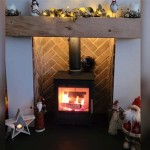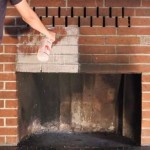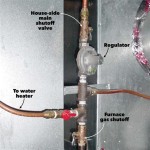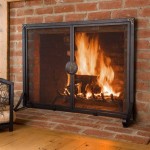What To Use To Clean Fireplace Glass: A Comprehensive Guide
Fireplace glass, while adding aesthetic appeal and providing a barrier for safety, is prone to accumulating soot, creosote, and ash. These deposits not only diminish the visual enjoyment of the fire but can also indicate inefficient burning and potential fire hazards. Maintaining clean fireplace glass is therefore crucial for both aesthetic and safety reasons. This article explores various methods and materials for effectively cleaning fireplace glass, detailing the pros and cons of each approach.
The selection of the appropriate cleaning method depends on several factors, including the severity of the buildup, the type of glass, and personal preferences. Some methods are more aggressive, requiring careful application to prevent damage, while others are gentler and may require repeated application. Understanding the characteristics of each method allows for a more informed decision, ensuring the glass is cleaned effectively without compromising its integrity.
Understanding the Nature of Fireplace Glass Deposits
Before delving into cleaning methods, it is essential to understand the composition of the deposits on fireplace glass. Soot is primarily composed of carbon particles resulting from incomplete combustion. Creosote, a more problematic substance, is a byproduct of burning wood, containing a complex mixture of tars, oils, and other organic compounds. Ash comprises the non-combustible mineral residues left after the wood is burned. The presence of these substances, particularly creosote, not only obscures the view of the fire but also poses a fire risk, as creosote is highly flammable and can accumulate in the chimney, leading to chimney fires.
The adherence of these deposits to the glass is influenced by several factors, including the temperature of the glass, the moisture content of the wood burned, and the efficiency of the fireplace's ventilation system. Higher temperatures and drier wood tend to result in more complete combustion, reducing soot and creosote buildup. Conversely, burning damp wood or operating with an inefficient ventilation system increases the deposition of these materials on the glass.
Furthermore, the type of wood burned significantly affects the composition of the deposits. Softwoods, such as pine, tend to produce more creosote than hardwoods, such as oak or maple. Therefore, selecting the appropriate type of wood is crucial for minimizing the buildup of deposits and maintaining a cleaner fireplace glass.
Cleaning Methods and Materials
Several methods and materials can be employed to clean fireplace glass, ranging from commercial cleaners to homemade solutions. Each method possesses distinct advantages and disadvantages, requiring careful consideration of the specific circumstances and preferences.
Commercial Fireplace Glass Cleaners: These cleaners are specifically formulated to remove soot, creosote, and ash from fireplace glass. They typically contain a blend of solvents, detergents, and abrasives designed to dissolve and lift the deposits. Commercial cleaners are generally effective and convenient, often available in spray or gel form. However, it is crucial to follow the manufacturer's instructions carefully, as some cleaners can be corrosive and may damage the glass or surrounding surfaces if misused. Ensuring adequate ventilation during application is also essential, as some cleaners may release volatile organic compounds (VOCs). Always wear appropriate protective gear, such as gloves and eye protection, when using commercial cleaners.
Homemade Cleaning Solutions: A popular alternative to commercial cleaners is using homemade solutions. These solutions often utilize readily available household ingredients, making them a cost-effective and environmentally friendly option. One common homemade solution involves mixing equal parts of white vinegar and water in a spray bottle. The acidic nature of vinegar helps to dissolve soot and ash without being overly abrasive. Another effective solution involves mixing baking soda with water to form a paste. The slightly abrasive texture of baking soda aids in scrubbing away stubborn deposits. When using homemade solutions, it is important to test the solution on a small, inconspicuous area of the glass first to ensure it does not cause any discoloration or damage.
The Newspaper and Ash Method: This traditional method involves using damp newspaper dipped in fireplace ash to scrub the glass. The ash acts as a mild abrasive, helping to remove the deposits, while the newspaper provides the necessary scrubbing action. This method is particularly effective for lighter deposits and is generally considered safe for most types of fireplace glass. However, it may not be sufficient for removing heavy creosote buildup. To use this method, dampen a sheet of newspaper and dip it into the ash. Gently scrub the glass in a circular motion, applying moderate pressure. Rinse the glass with clean water and dry with a clean cloth.
Razor Blade Scraping: For extremely stubborn deposits that resist other cleaning methods, a razor blade scraper can be used. This method requires extreme caution, as improper use can easily scratch or damage the glass. It is essential to use a new, sharp razor blade and hold it at a shallow angle to the glass surface. Gently scrape the deposits away, avoiding excessive pressure. It is recommended to lubricate the glass surface with a mild cleaning solution before scraping to minimize the risk of scratching. This method should only be used as a last resort and with extreme care.
Step-by-Step Cleaning Procedures
Regardless of the chosen cleaning method, a systematic approach is crucial for achieving optimal results and minimizing the risk of damage. The following steps outline a general cleaning procedure applicable to most methods:
Preparation: Allow the fireplace to cool completely before commencing any cleaning activities. This is essential for safety and prevents the cleaning solution from evaporating too quickly. Protect the surrounding area with drop cloths or newspaper to catch any drips or spills. Gather all necessary cleaning materials, including the chosen cleaner, spray bottle, sponge, scrub brush, razor blade (if needed), clean water, and clean cloths.
Application: Apply the chosen cleaner evenly to the fireplace glass. If using a spray cleaner, spray directly onto the glass, ensuring a thorough coating. If using a paste or powder, apply it with a sponge or cloth. Allow the cleaner to dwell on the glass for the recommended time, typically a few minutes, to allow it to loosen the deposits.
Scrubbing: Using a sponge or scrub brush, gently scrub the glass in a circular motion. Apply moderate pressure to remove the deposits. For stubborn deposits, use a more abrasive scrub brush or the newspaper and ash method. If necessary, use a razor blade scraper to carefully remove the deposits, ensuring to lubricate the glass surface and hold the blade at a shallow angle.
Rinsing: Rinse the glass thoroughly with clean water to remove all traces of the cleaner and loosened deposits. Use a sponge or cloth to wipe away the water, ensuring no residue remains.
Drying: Dry the glass with a clean, lint-free cloth. This will prevent water spots and streaks from forming. Buff the glass to a shine for a clear and sparkling finish.
Preventive Measures
Preventing the buildup of deposits on fireplace glass is often more effective than trying to remove them after they have accumulated. Several preventive measures can be implemented to minimize soot, creosote, and ash deposition:
Use Seasoned Wood: Burning well-seasoned wood with a moisture content of less than 20% reduces the amount of smoke and creosote produced. Seasoned wood burns hotter and more efficiently, resulting in less incomplete combustion and fewer deposits on the glass.
Burn Hardwoods: Hardwoods, such as oak, maple, and ash, produce less creosote than softwoods, such as pine and fir. Opting for hardwoods whenever possible minimizes the buildup of deposits.
Ensure Proper Ventilation: Proper ventilation is crucial for efficient burning and reducing creosote buildup. Ensure the fireplace damper is fully open during operation and that the chimney is free of obstructions. Regular chimney inspections and cleaning are essential for maintaining proper ventilation.
Burn Hot Fires: Burning hot fires promotes more complete combustion, reducing the amount of smoke and creosote produced. Avoid smoldering fires, as they tend to generate more deposits.
Regular Cleaning: Cleaning the fireplace glass regularly, even if it only has a light coating of soot, prevents the deposits from hardening and becoming more difficult to remove. Wipe down the glass with a damp cloth after each use to minimize buildup.

How To Clean A Fireplace With Bar Keepers Friend

How To Clean Hazy Gas Fireplace Glass Nonprofit Home Inspections

Do Gas Fireplaces Need To Be Cleaned Direct Learning Center

Sdy White Cleans Fireplaces Stoves Stonework Gas Fireplace Glass And More

How To Clean Fireplace Glass Doors Fast Easily

How To Clean The Glass On Your Gas Fireplace

Tips For Cleaning Your Fireplace Direct Fireplaces

How To Clean The Glass On Your Gas Fireplace

How Do I Clean My Fireplace Glass We Love Fire

How Do I Clean My Fireplace Glass We Love Fire
Related Posts








